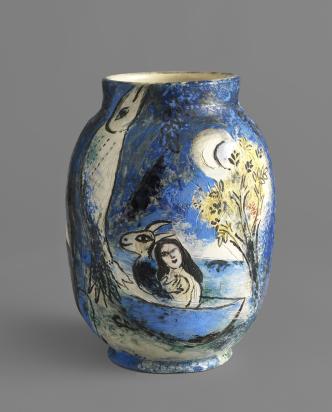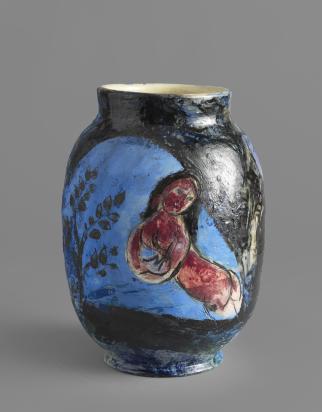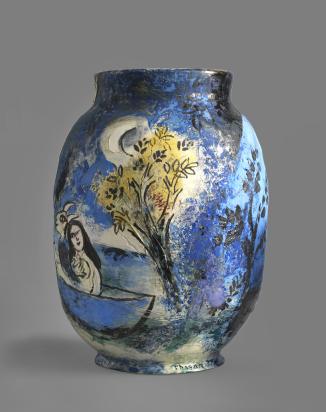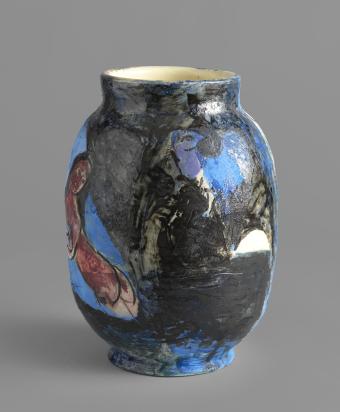Chagall began making vases in 1951. The Dream (1952) is one of his first. While its shape is plain and functional, the decoration is rich and painterly. Chagall achieved this by adding successive layers of engobes and oxides and removing material using a technique inherited from sgraffito1 recalling engraving. This vase with an “ovoid body” and “wide opening”, certainly made at the Madoura studio2, reflects formal preoccupations also found in Large Face and Bird [Grand visage et oiseau] (1952) or Profile and Nude or Paradise Blue Vase [Profil et nu ou Vase bleu paradis] (1953). It calls for “historiated development around the rim”, according to Sylvie Forestier.3
The intense blue color, revealed after firing, recalls the Mediterranean landscape that Chagall fell in love with during 1926 a trip to the Côte d'Azur4 and rediscovered when he moved there in 1949 after the tragedy of the Second World War. A monumental fish rises up to the neck of the vase. Part of Chagall’s bestiary and a Judeo-Christian symbol, the fish was depicted by the artist in various media, including ceramics (Fish [Le Poisson] (1952) or Still Life With Fish [Nature morte au poisson] (1952)) and sculpture (Woman With Fish [Femme au poisson] (1952)). The fish looks over a woman and a man with an animal's head sailing on a boat. They are probably Titania and Bottom, as suggested by the title of this ceramic evoking Shakespeare's A Midsummer Night's Dream, which is set in Greece. The theme, which Chagall addressed in painting (Midsummer Nights Dream [Le Songe d'une nuit d'été] (1939)]) and ceramics (Midsummer Nights Dream [Le Songe d'une nuit d'été] (1952)), illustrates his fondness for the performing arts, an interest that was a running thread through his work since his first stage sets and costumes designed in Moscow in 1919,5 such as one of the four panels for the auditorium of the Jewish Art Theatre (GOSEKT): Jewish Art Theater, Moscow: panel for Theater [Théâtre d'art juif, Moscou : panneau pour Le Théâtre] (1920).
The second side features a red, seemingly floating female nude surrounded by a shimmering, mysterious black halo contrasting with the matte blue that strengthens the fantastic, theatrical atmosphere of the other side. Chagall explored these shades of deep, luminous black visible on many ceramics (Lovers With Goat [Amoureux avec chèvre] (1950), A Visit from the Donkey [L'Âne en visite] (1950)), which recall India ink and “echo the washes of the same period”,6 such as the series illustrating the Contes de Boccace,6 including The Cradle (illustration no. 24), 1949-1950.
-
Marc CHAGALL, The Dream (Le Songe), 1952, white clay, decorated with slips and oxides, engraved with a knife and dry point needle, partially enameled with brush, 13 1/4 x 9 3/16 x 9 3/16 in. (33.7 x 23.3 x 23.3 cm), Private collection © Fabrice GOUSSET/ADAGP, Paris, 2026
-
Marc CHAGALL, The Dream (Le Songe), 1952, white clay, decorated with slips and oxides, engraved with a knife and dry point needle, partially enameled with brush, 13 1/4 x 9 3/16 x 9 3/16 in. (33.7 x 23.3 x 23.3 cm), Private collection © Fabrice GOUSSET/ADAGP, Paris, 2026
-
Marc CHAGALL, The Dream (Le Songe), 1952, white clay, decorated with slips and oxides, engraved with a knife and dry point needle, partially enameled with brush, 13 1/4 x 9 3/16 x 9 3/16 in. (33.7 x 23.3 x 23.3 cm), Private collection © Fabrice GOUSSET/ADAGP, Paris, 2026
-
Marc CHAGALL, The Dream (Le Songe), 1952, white clay, decorated with slips and oxides, engraved with a knife and dry point needle, partially enameled with brush, 13 1/4 x 9 3/16 x 9 3/16 in. (33.7 x 23.3 x 23.3 cm), Private collection © Fabrice GOUSSET/ADAGP, Paris, 2026
-
Marc CHAGALL, The Dream (Le Songe), 1952, white clay, decorated with slips and oxides, engraved with a knife and dry point needle, partially enameled with brush, 13 1/4 x 9 3/16 x 9 3/16 in. (33.7 x 23.3 x 23.3 cm), Private collection © Fabrice GOUSSET/ADAGP, Paris, 2026
-
Marc CHAGALL, The Dream (Le Songe), 1952, white clay, decorated with slips and oxides, engraved with a knife and dry point needle, partially enameled with brush, 13 1/4 x 9 3/16 x 9 3/16 in. (33.7 x 23.3 x 23.3 cm), Private collection © Fabrice GOUSSET/ADAGP, Paris, 2026











